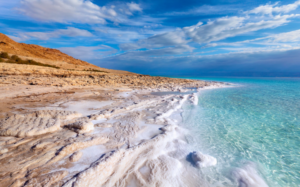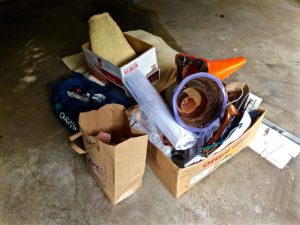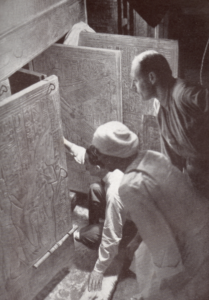The times being what they are, I recently decided that it might be prudent to diversify from writing books into some other kind of industry. I quickly hit on the ideal thing: Sea salt. Since “disrupting” markets is apparently the thing these days, as opposed to the old fashioned concept of merely building better products than the next guy, I decided to try and disrupt the sea-salt market by using sea salt in items where one typically would not expect to find it.
First, however, I needed to do some market research to see what products already included sea salt. The list is dizzying. There are caramels, of course, and almonds, popcorn, and potato chips, the usual salty foods, only now with the term sea salt added to their packaging. But even in this snack-food category I found wild variety—veggie strips, bean chips, and Tesco Finest’s “Hand cooked Cornish Sea Salt & West Country Cider Vinegar Crisps.” A company called Epic sells “Sea Salt and Pepper Artisanal Pork Rinds” made with “Pork Skins Raised Without Antibiotics,” a compelling product, though I personally do not know how anyone can raise a pork skin, with or without antibiotics, unless somewhere there is a pork-skin ranch like Gary Larson’s boneless chicken ranch. This may be irrelevant, but I wondered too if a pork skin might qualify as a service animal when I travel by air. There are crackers, chocolate bars, and ice creams, and at least one company adds sea salt to cottage cheese. The Ciao Bella folks, covering a lot of bases, make a pumpkin sea salt caramel gelato.
I quickly discovered that sea salt had sifted its way into lots of other product categories as well. Target sells a “Moroccan Sea Salt Spray” for hair. Herbivore Botanicals goes one better, and combines coconut and sea salt into a hair spray it calls “Sea Mist,” which, according to one retailer, “manages, magically, to bottle the effect of sea mist so you can have it all the time.” You can also spray it on your skin, “for a moisturizing and invigorating pick-me-up.” And there is the alluringly named AHAVA “Dead Sea Crystal Osmoter X6 Facial Serum,” containing sea salt from the Dead Sea. I personally have misgivings about putting anything on my face that contains the word dead, but this appears to be AHAVA’s specialty. The company also makes Dead Sea body lotions, shower gels, a foot cream, and various soaps, like its “Purifying Dead Sea Mud Soap.” A competitor, Purity Beauty, sells a “Dead Sea Mudcake,” whose packaging shows a gleefully smiling model with one half of her face covered with black mud or possibly axle grease.
I also found products that were, well, just salt, intended for seasoning food, but which happened to come from a sea somewhere, with the most popular points of origin being the Coral Sea, Red Sea, Celtic Sea, Black Sea, and all of Utah. Zuuna makes “Pure Mediterranean Cyprus Black Lava Sea Salt” crystal flakes, which have the added advantage of being “solar harvested.” Hepp’s Salt Co. makes a “Black Truffle Finishing Sea Salt” which retails for $22.75 for a 2.5-ounce pouch, so you see why I decided to get into this business. Wild Cheff makes “Cherry Wood Smoked Sea Salt,” though I have no idea how one goes about smoking sea salt. Nor do I have any idea why the company put two ffs in Cheff, but then, as readers of this blog know well, Oreo’s Double Stuf cookie has only one f, which leads me to suspect there may be a global arrangement akin to carbon-trading in which companies swap f’s so as to avoid overloading the world with the sixth letter of the alphabet, a futile endeavor, at least here in New York City, where the letter f is deployed lavishly in routine street-corner discourse.
Reading about all these products set my imagination on fire. Ideas began shuttering through my brain like film running through an old Bell & Howell movie projector, the kind that used to melt the film at regular intervals causing macabre effects on the projection screen as if a nuclear weapon had gone off at Aunt Maude’s Sunday afternoon cook-out. I envisioned sea salt Oreo cookies, sea salt gummy bears, sea salt Twizzlers, and sea salt condoms. I contemplated adding sea salt to fruitcake, because why not, no one eats it anyway, and to those little marzipan fruits which always turn up in your Christmas stocking and look so yummy but aren’t.
Throughout my research, a thought kept occurring to me: does anyone test to see if these things contain salt that actually comes from the sea? I briefly considered pouring a couple of ounces of Morton’s table salt into a snazzy package, adding some Rogaine, and calling it “Erik’s Rogue Wave Sea-Salt Hair Enhancer,” but then my ankle monitor began to itch and I decided I had done enough research.
Now I needed a supply of salt. One of the biggest suppliers of bulk sea salt is Lake Products Co., out of Florissant, Missouri, which is 943 miles from the nearest ocean beach, which is kind of a catty thing to point out, but, I have to be me. The company sells sea salt in big pails that are colored a very pretty sea-green. Its flagship product, “Sea-Salt ASTM D1141-98 (Re-approved 2013) Formula a, Table x1.1, Section 6 (Original standard ASTM D1141-52),” is used “for the preparation of substitute ocean water.” Not just any ocean water, but standardized ocean water that allows researchers to eliminate the variability between, say, a pail of sea water from the Gulf of Mexico and one from the coast of Victoria, B.C., though I am being unfair here because Victoria still dumps raw sewage into the ocean so of course a pail of Victoria sea water will be different. It may be off point to note that in Victoria sewage protestors deploy a man dressed in a body-length brown tube to prance along the shoreline. His name is Mr. Floatie, and you can catch him on You Tube. https://www.youtube.com/watch?v=W-NWbzB3ut0
The sea salt sold by Lake Products can be precisely mixed to yield the same salinity every time. As the company says, “It standardizes seawater conditions for many uses including accelerated corrosion studies, oceanographic research, ocean instrument calibration and chemical research testing.” It can also be used as a “tissue muscle preservative.” A big 50-pound pail will make 143 gallons of artificial seawater, and sells for $317. Or you can shortcut the process and buy premixed artificial seawater, for $180 per 5-gallon container, something I would like to see Amazon just try to deliver with a drone.
Now came the fun part, actual hands-on experimentation, trying to see how disruptive I could get. First I tried putting sea salt in gasoline. For this experiment I surreptitiously enlisted my neighbor, or rather, his brand-new Audi Q7 SUV. As he pulled away I discovered that his exhaust left behind a pleasant scent of the sea. He stopped halfway down the block and popped open his hood, and spent a good five minutes staring inside, as if he imagined he could learn anything by looking into the engine compartment of a German automobile. For some reason he spotted me—possibly because of my white lab coat and my clipboard. Thinking fast, I turned and ran down the block as if pursuing a thief, shouting “stop that guy—he put something in Bob’s fuel tank!”
Next, I tried mixing sea salt into contact-lens solution, thinking it was a natural fit because saline is a good thing for eyes, but I may have gotten the proportions wrong, or used the wrong salt. My wife was very unhappy with me, but she looks good in her new glasses.
Then I thought, wouldn’t it be interesting to try putting sea salt in Band-Aids. This too proved problematic. For reasons I cannot fathom parents felt uneasy about a man in a white coat with a clipboard loitering around the monkey bars waiting for small children to get cuts and scrapes.
Thinking that it might be best to stick to familiar territory, I began to wonder how I could apply emerging sea-salt technologies to the art and craft of writing books. I tried pouring sea salt into my laser printer. This did not work. Next I tried mixing sea salt with ink, to use in a fountain pen. I used Dead Sea sea salt, thinking I could market the ink by making some kind of allusion to the Dead Sea scrolls—“ink that won’t fade with time!”—but the crystals invariably clogged the pen point.
I thought about urging my publisher to sprinkle the covers of my books with sea salt, especially my book about the sinking of the Lusitania (Dead Wake), to add an additional sensory quality to the reading experience, but a few seconds into my call my publisher said “I’m sorry, I have to go. I’m late for an electroshock appointment.”
I decided then to abandon the whole sea-salt thing and instead try disrupting the next big market: juice cleanses. I don’t want to get anyone’s hopes up, but, it looks like I may have found a use for my leftover sea salt.













